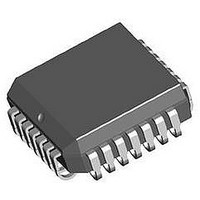CS61574A-IL1Z Cirrus Logic Inc, CS61574A-IL1Z Datasheet - Page 15

CS61574A-IL1Z
Manufacturer Part Number
CS61574A-IL1Z
Description
IC T1/E1 Ln Intrfc Unit F/Stratum-4 Apps
Manufacturer
Cirrus Logic Inc
Datasheet
1.CDB61574A.pdf
(34 pages)
Specifications of CS61574A-IL1Z
Ic Interface Type
Serial
Supply Voltage Range
4.75V To 5.25V
Power Dissipation Pd
290mW
Operating Temperature Range
-40°C To +85°C
Digital Ic Case Style
LCC
No. Of Pins
28
Rohs Compliant
Yes
Lead Free Status / RoHS Status
Lead free / RoHS Compliant
Available stocks
Company
Part Number
Manufacturer
Quantity
Price
Company:
Part Number:
CS61574A-IL1Z
Manufacturer:
Cirrus Logic Inc
Quantity:
10 000
Company:
Part Number:
CS61574A-IL1ZR
Manufacturer:
CIRRUS
Quantity:
1 000
Company:
Part Number:
CS61574A-IL1ZR
Manufacturer:
Cirrus Logic Inc
Quantity:
10 000
The FIFO in the jitter attenuator is designed to
prevent overflow and underflow. If the jitter am-
plitude becomes very large, the read and write
pointers may get very close together. Should they
attempt to cross, the oscillator’s divide by four
circuit adjusts by performing a divide by 3 1/2 or
divide by 4 1/2 to prevent the overflow or under-
flow. During this activity, data will never be lost.
The difference between the CS61575 and
CS61574A is the depth of the FIFO in the jitter
attenuator. The CS61575 has a 192-bit FIFO
which allows it to attenuate large amplitude, low
frequency jitter as required by AT&T 62411 (e.g.,
28 UIpp @ 300 Hz). This makes the CS61575
ideal for use in T1 Customer Premises Equipment
which must be compatible with AT&T 62411 re-
quirements. In single-line Stratum 4, Type II
systems which are loop-timed, he CS61575 re-
covered clock can be used as the transmit clock
eliminating the need for an external system clock
synchronizer. In Stratum 4, Type I systems which
transfer timing and require a clock synchronizer,
the CS61575 simplifies the design of the synchro-
nizer by absorbing large amplitude low frequency
jitter before it reaches the synchronizer.
DS154F3
Figure 12. Typical Jitter Transfer Function
The CS61574A has a 32-bit FIFO which allows it
to absorb jitter with minimum data delay in T1
and E1 switching or transmission applications.
The CS61574A will tolerate large amplitude jitter
by tracking rather than attenuating it, preventing
data errors so that the jitter may be absorbed in
external frame buffers. With large amplitude input
jitter, the CS61574A jitter transfer function may
exhibit some jitter peaking, but will offer per-
formance comparable to the CS61574.
The jitter attenuator may be bypassed by pulling
XTALIN to RV+ through a 1 kΩ resistor and pro-
viding a 1.544 MHz (or 2.048 MHz) clock on
ACLKI. RCLK may exhibit quantization jitter of
approximately 1/13 UIpp and a duty cycle of ap-
proximately 30% (70%) when the attenuator is
disabled.
Local Loopback
Local loopback is selected by taking LLOOP, pin
27, high or by setting the LLOOP register bit via
the serial interface.
The local loopback mode takes clock and data
presented on TCLK, TPOS, and TNEG (or
TDATA), sends it through the jitter attenuator and
outputs it at RCLK, RPOS and RNEG (or
RDATA). If the jitter attenuator is disabled, it is
bypassed. Inputs to the transmitter are still trans-
mitted on TTIP and TRING, unless TAOS has
been selected in which case, AMI-coded continu-
ous ones are transmitted at the TCLK frequency.
The receiver RTIP and RRING inputs are ignored
when local loopback is in effect.
CS61574A CS61575
15
















